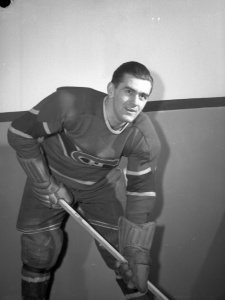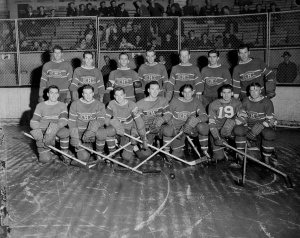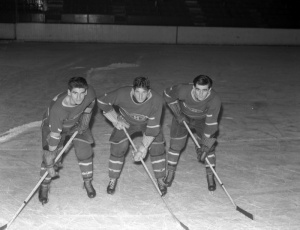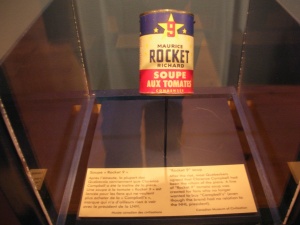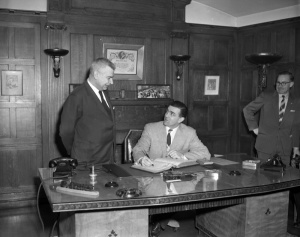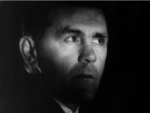Maurice Richard, the Hockey Player (part 1)
par Perrone, Julie
In becoming the greatest hockey player of his time, Maurice Richard also became a hero for all French Canadians. Following the riot provoked by his suspension in 1955, he developed a following that worshiped him to the point of creating a legend. The series of events that made him a hero coincide with the ever-changing values arising within Quebec and Canadian society. It is important to note that Richard's rise to greatness and celebrity status would not have been possible if it were not for his incredible athletic ability and sporting accomplishments. His great achievements, coupled with a particularly unique social context forged his status as a hero.
Article disponible en français : Maurice Richard, 1ère partie: le hockeyeur
Maurice "Rocket" Richard, Star Player of the Montreal Canadiens
Maurice Richard spent his career with the Montreal Canadiens from 1942 to 1960. Maurice Richard, nicknamed the "Rocket" due to his extraordinary speed on the ice, has been credited with over 600 goals and numerous other accomplishments. He is without a doubt one of the greatest athletic heroes Quebec has ever known.
Richard rose to hero status on the 8th of November, 1942 when he scored his first goal in the Canadien's blue, white and red uniform. In all of the daily newspapers in Montreal, he was already being compared to the legendary Howie Morenz, the deeply missed number 7. This comparison illustrates how people felt about Richard's talent. Expectations were high among fans and sports journalists. Unfortunately, like many beginning young players, he was often criticised and even considered to be a "lemon" [a player not worth his oats] when his performance did not meet expectations. It was even feared that he was a bad investment because his career was slowed by numerous injuries. However, gradually, the Rocket became a revered goal scorer who was often talked about both because of his hot temper and his extraordinary athletic performance.
One of Richard's first legendary performances took place on the 17th of December 1944. Richard and Bob "Killer" Dill of the New York Rangers, known for his unsportsmanlike behaviour, engaged in a memorable fistfight on the ice in New York. The immense media coverage that preceded the game had a polarising effect, matching the "goal scorer" against "the fighter". Journalists also compared their respective origins pitting French-speaking Quebec against English-speaking New York. Against all expectations, and perhaps in response to the media coverage, Richard gave a hard blow to Dill. Later, in another game, Richard managed to score a goal despite being watched closely by on of the opposing Detroit Red Wings' defenders, Earl Seibert. Seibert had even held on to Richards shoulders to slow him down. However, the Rocket continued his headlong rush scoring with only one hand on his stick.
It would however take several memorable events to bring about a change in Maurice Richard's status from an average player to a star player. An example of this is the goal he scored in 1952 in a semi-conscious state after receiving a hard check to the head. There is also his record fifty goals in fifty games, as well as his becoming the first player to score 500 goals in his career. These accomplishments brought the Rocket's popularity to new heights.
The emergence of Richard's legacy is characterised by a progressive softening of his tough-as-nails image accompanied by his growing list of achievements. Richard was originally known as an explosive player who often reacted violently, unexpectedly and sometimes inappropriately. Later in his career, people sought to justify his actions. They say his violent acts were due to his natural temperament (and thus excusable) or were reactions to the attitudes of other players. Immediately following the events of December 17th, 1944, Maurice Richard was accused by journalists of bullying Bob "Killer" Dill. They said his acts were cheap shots. However, in 1998, it was explained that Richard had been provoked by Dill's ethnic remarks. Following another game, an altercation with a referee was reported in two different versions by morning papers. In one version, Richard had apparently pushed a referee and, in the other, he had reportedly "attacked" him. Gradually, the version retained by the population was the one given by Richard himself-which was of course in his own favour. Similarly, although there were two versions describing the events leading to Richard's famous 1955 suspension, only one would survive the test of time. People prefer to say that Richard punched a referee in the face because he was dizzy and could barely see, rather than saying he was attempting to get revenge.
As for his most celebrated accomplishments, as more time passes, more we learn about the details of the events surrounding them. His record of five goals and eight points on December 28th, 1944 is one such example. Setting the record was a great feat in its own right, but it reaches mythical proportions when we learn that Richard had moved into a new residence that same day. In addition to that, years later we learned that Richard had broken his stick and had to play the game with another player's stick.
Several years after his amazing one-handed goal with defenseman Earl Seibert on his back, the story developed into an even more impressive tale. The day after the game, people spoke only about the outcome, however, as details gradually came to the surface, the story reached new epic proportions. In 1960, it was written that Seibert weighed 198 lbs. This was changed to 225 lbs in 1998 and 250 lbs in 2005. We see the same phenomenon in play with respect to the goal that Richard scored in an apparently semi-conscious state on the 8th of April, 1952. The day after the game, the daily papers made significantly different descriptions of Richard's injuries. Some papers said he had only a small cut, while others said that he was bleeding profusely as he slipped into a pool of blood. Today, it is commonly assumed that his injury was severe enough to trouble his vision and hearing and even bad enough to disturb his perception of reality.
The 1955 Suspension
On the 16th of March 1955, the National Hockey League (NHL) announced that Maurice Richard would be suspended. Richard would have to sit out the rest of the regular season and the playoffs. According to many sports journalists, it was one of the most severe punishments ever handed down by the NHL. The events resulting in the suspension happened during a game on the 13th of March. Richard hit Hal Laycoe of the Boston Bruins with his stick in retaliation for a hit Laycoe had given him earlier. A skirmish then broke out that required the officials to intervene. The Rocket received a game misconduct after punching one of the officials in the face.
The day after the game, the events were investigated by the NHL, which tried to evaluate the severity of the acts committed and decide on a fair punishment. The decision was announced on the 16th of March, read from a declaration signed by Clarence Campbell, the then president of the NHL. Campbell stated that Richard's poor conduct justified the decision, which attempted to send a strong message to discourage this type of behaviour. That very same night, the Canadiens were supposed to play and Campbell himself promised to be there. The decision was considered as an outrage by Canadiens' fans. Outside the Montreal Forum, crowds gathered waving signs that read "À bas Campbell" [Down with Campbell] and "Vive Richard" [Long Live Richard]. The game was interrupted midway when a fan set off tear-gas inside the building, causing the Forum to be evacuated. The immense crowd in the streets erupted into a riot, breaking windows, jumping on cars and setting fires in garbage cans. The rioting continued until 2:00 in the morning after several arrests were made.
The next day, Maurice Richard was on the front page of every paper in the country. Despite being mainly a sports story, the extreme emotional reaction of the crowd made the story important news for everyone. Richard even appeared publicly to urge people to calm down. From that day on, the Rocket became more than just a player. He reached beyond the confines of the Forum and touched the lives of everyone.
Thereafter, everyone spoke of the suspension as being unfair and said that the consequences of the event were too penalising. People spoke of the Canadiens' dwindling chances of winning the Stanley Cup. Despite everything, the team eventually made it to the finals, closely losing to the Detroit Red Wings. The loss, however, had a positive impact on Richard's growing legacy, as people spoke of what might have been had the Rocket been allowed to play.
The riot would often be interpreted as being a public display of ethnic tension that existed within Quebec society. Though it was originally seen as a result of a single skirmish on the ice, the event took on a whole new meaning, as it was reinterpreted by the journalist André Laurendeau. The journalist, who commented four days later, was the first to give a nationalist significance to the event. This new angle presented Richard as being forced to react violently, rather than his reaction being a symptom of his own short temper. The new link made between Richard and a social cause, whether it was his own doing or not, and made him a hero in the eyes of many.
1955 to 1960: Five Stanley Cups, but No Legends
After 1955, Maurice Richard continued to dominate on the ice. However, his actions were not analysed nor did they result in public debate like they had in previous years. Despite the fact that the Rocket was a major reason why the Canadiens won five Stanley Cups, his plays were less dramatic than before (i.e., no semiconscious plays or one-handed goals with 200-lb defenders on his back). His performance was spectacular nonetheless and he continued to score goals. It seemed that his suspension actually did him some good. Statistics show that he actually spent less time in the penalty box afterwards and his temper actually cooled somewhat. He was in fewer fights and received more ice-time. Perhaps he was conscious of the pressure that was on him. Whatever the reason, the Rocket continued to be admired. He finished his career with five consecutive Stanley Cup wins and a record for the most goals scored in his career.
On the 18th of October, 1957 the Rocket reached another great milestone: his 500th career goal. He became the first player in history to reach that point. The media not only covered the goal itself but also spoke a great deal about the fact that he was the oldest player in the NHL. Both Montreal and Toronto media underlined the importance of his 500th goal. It was described in great detail using rather creative writing. One of the papers reads, "Maurice Richard is a wizard". The goal "glistened" and was scored "as if by magic". The players on the ice during that goal also seemed to be struck with the grandeur of the milestone. All those who were witness are now a part of history and the papers seem to agree.
From Star Player to a Popular Hero
Following his 500th goal Richard's popularity continued to increase. In 1959, the planned construction of an arena named after him was announced. The arena was inaugurated in 1962. Richard retired in 1960 and immediately thereafter, the Canadiens retired his number 9 jersey as well. In 1961, he was inducted into the Hockey Hall of Fame. He was also inducted into the Panthéon du Sport du Québec in 1985. Most of these honors were organised by people from the Quebec sporting world, although many other awards would follow. Richard was often seen as an extraordinary player that represented a cultural minority in Canada. In 1999, the Rocket was again honoured when the NHL created the Maurice Richard Trophy for the player that scores the most goals in the regular season. The Rocket went from being a prize recipient to becoming a prize himself.
A Lasting Heritage Legacy
The way in which the general public views the Rocket continues to evolve. The changes observed in how he is perceived coincide with the evolution of the ever-changing dynamics of society. The Rocket's story has two chapters: the real story, spectacular as it is, and the constantly changing tale that is more a reflection of our changing perceptions of the events, than it really is actual story of his life. This legendary second chapter resonates with the changing values and needs of society.
Julie Perrone
Doctoral Student,
Concordia University
NOTES
In 1960: Andy O'Brien, Rocket Richard, Toronto: Ryerson Press, 1961, 96; in 1998: Jean-Marie Pellerin, Maurice Richard. L'idole d'un peuple, 36; in 2005: Paul Daoust, "17th March 1955: 50 ans plus tard - L'émeute au Forum, première révélation du mythe Richard, » Le Devoir, 17th March, 2005.
« On a tué mon frère Richard », Le Devoir, 21st March,1955.
BIBLIOGRAPHY
Carrier, Roch, Le Rocket, Montréal, Stanké, 2000, 304p.
Gosselin, Gérard, Monsieur Hockey, Montréal, Les Éditions de l'Homme, 1960, 125p.
Melançon, Benoît, Les yeux de Maurice Richard. Une histoire culturelle, Montréal, Éditions Fides, 2006, 279p.
O'Brien, Andy, Rocket Richard, Toronto, Ryerson Press, 1961, 134p.
Pellerin, Jean-Marie, Maurice Richard. L'idole d'un peuple, Montréal, Les Éditions Trustar, 1998, 517p.
Maurice Richard, long métrage de Charles Binamé, Canada, 2005, avec Roy Dupuis.
Gruneau, Richard et David Whitson, Hockey Night in Canada : Sport, Identities and Cultural Politics, Toronto, Garamond Press, 1993, 312p.
Ramos, Howard et Kevin Gosine, « The Rocket: Newspaper Coverage of the Death of a Quebec Cultural Icon, a Canadian Hockey Player », Journal of Canadian Studies, vol. 36, n° 4, 2002, pp. 9-31.
Additional DocumentsSome documents require an additional plugin to be consulted
Images
-
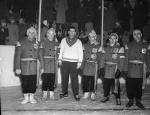 Carnaval, Ferme-Neuve
Carnaval, Ferme-Neuve
, 1958 -
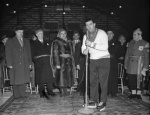 Carnaval, Ferme-Neuve
Carnaval, Ferme-Neuve
, 1958 -
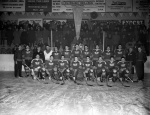 Carnaval, Ferme-Neuve
Carnaval, Ferme-Neuve
, 1958 -
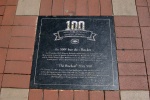 Place du Centenaire -
Place du Centenaire -
100 Meilleurs ...
Vidéo
Documents sonores
-
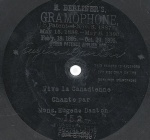 La chanson des étoiles du hockey
Interpreter : Denise Émond.
Writer : Jean Grimaldi, Denise Émond.
Album : Une Simple Mélodie, 1956.
La chanson des étoiles du hockey
Interpreter : Denise Émond.
Writer : Jean Grimaldi, Denise Émond.
Album : Une Simple Mélodie, 1956.
-
 Maurice Richard
Interpreter : Jeanne-D'Arc Charlebois.
Writer : Yvon Dupuis, Jean Laurendeau.
Album : Une Simple Mélodie, 1950.
Maurice Richard
Interpreter : Jeanne-D'Arc Charlebois.
Writer : Yvon Dupuis, Jean Laurendeau.
Album : Une Simple Mélodie, 1950.
-
 Rocket Rock'n Roll
Interpreter : Denise Filiatrault.
Writer : Jacques Lorrain, Roger Joubert.
Album : Une Simple Mélodie, 1957.
Rocket Rock'n Roll
Interpreter : Denise Filiatrault.
Writer : Jacques Lorrain, Roger Joubert.
Album : Une Simple Mélodie, 1957.
Documents PDF
-
 50e but de Maurice Richard
50e but de Maurice Richard
-
 André Laurendeau : « On a tué mon frère Richard »
André Laurendeau : « On a tué mon frère Richard »
-
 Appel au calme de Maurice Richard à la suite de l'émeute au Forum
Appel au calme de Maurice Richard à la suite de l'émeute au Forum
-
 Émeute au Forum: qui sème le vent...
Émeute au Forum: qui sème le vent...
-
 Émeute sans précédent : On réclame la démission de Campbell
Émeute sans précédent : On réclame la démission de Campbell
-
 Véritable foule ameutée au Forum
Véritable foule ameutée au Forum
Hyperliens
- Encyclopedia article: Maurice Richard: the Legendary Figure (part 2)
- Online Exhibition: Rocket Richard: A Hockey Legend and his Legacy, Canadian Museum of Civilization
- The Legendary #9: Maurice 'Rocket' Richard (CBC Digital Archives)
- The 'Richard Riot' (CBC Digital Archives)
- [IN FRENCH]: Maurice « Rocket » Richard (1921 - 2000)

